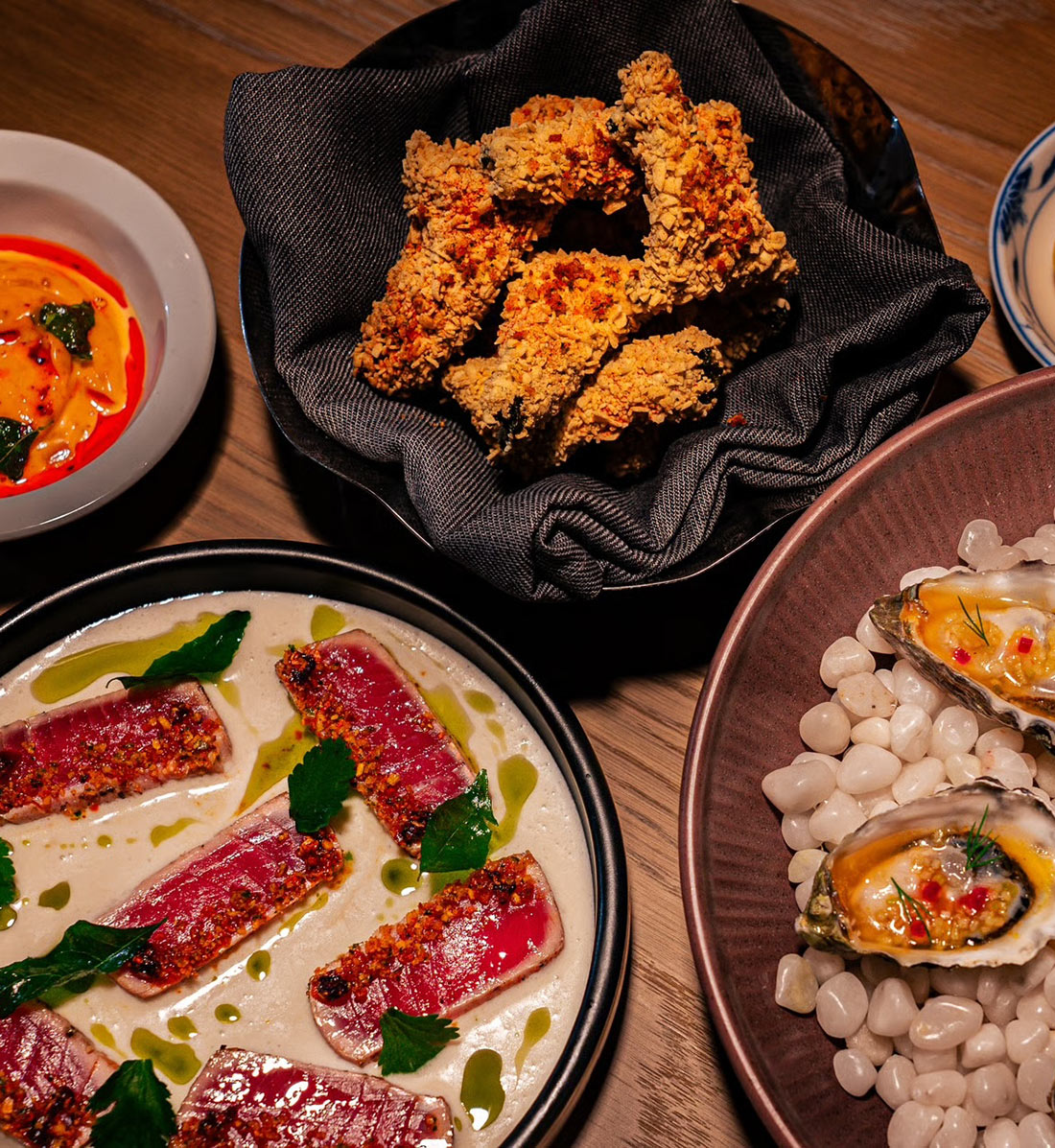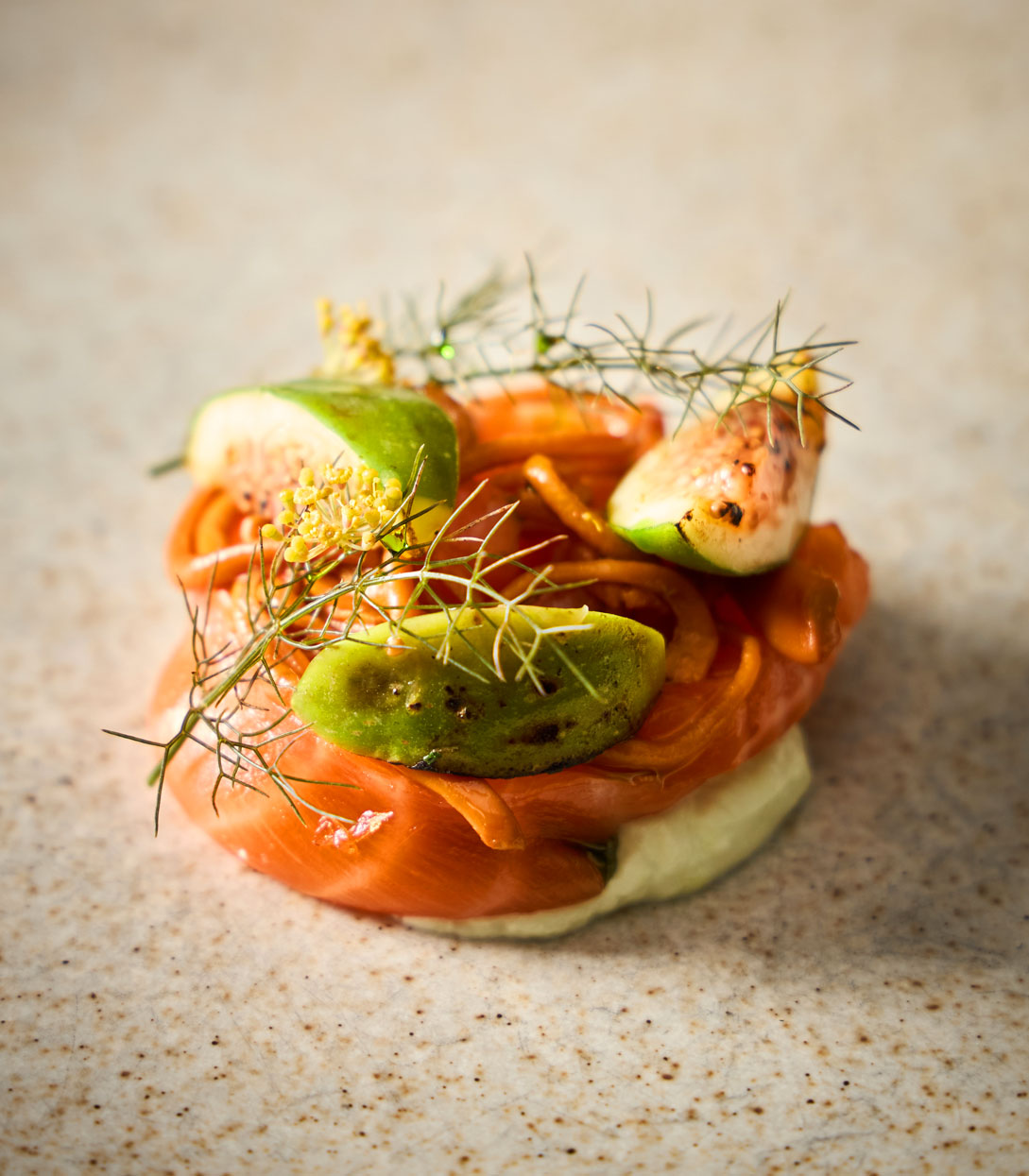Champagne and lemon are not a traditional pairing. However, many MICHELIN Star spots have embraced the pucker-friendly fruit for its complexity and acidity. Add France’s bubbly beverage, more frequently associated with oysters, caviar, brie, or strawberries, and the results are tantalizing.
That’s exactly why Krug Champagne’s Annual Single Ingredient Program spotlights the versatility of a singular common ingredient, from plate to pairing, and how that can be elevated around the world. Below, we chat with MICHELIN Star chefs from California to Hong Kong on how the humble lemon elevates, inspires, and challenges convention with flavor.
This year marks the Maison’s ninth ingredient spotlight—in the past tomato, potato, onion, and rice have been used—and the first featuring fruit. “One can not produce good wine without good elements,” says Renaud Butler, Chief Marketing & Commercial Officer at Krug Champagne. With over 200 citrus species in the world, and over 10,000 grape species, the parallels between champagne and lemons has never been so apparent.
So, what better way to highlight this marriage of ingredients than with the help of some MICHELIN Star chefs? To fuel innovation, the Maison invites a select group of chefs (many with MICHELIN pedigrees) to join them on an origins trip focusing on a single, local ingredient that's vital to the region. This year, 12 chefs visited Sao Paulo, Brazil—the state comprises 80 percent of the country’s citrus exports—for an immersive opportunity to learn more about lemons and on a broader scale, citrus.
We caught up with six of the chefs in attendance to learn about the dishes they created in anticipation of the trip, as well as what they took away from the journey.

Justin Cogley, Aubergine
Carmel-by-the-Sea, California
This California-based chef made a pistachio and lemon roasted, crispy chicken. He used Meyer lemons from the trees in his backyard where he also grows Oro Blanco and finger limes. “It’s something that people can do at home, not some crazy recipe that requires hours in the kitchen— and it highlights the champagne.”
Biggest takeaway: “To see this amount of lemons and citrus and to taste this many varieties is pretty amazing. And to see it grown 6,500 miles away from where I live—I see some of the same ingredients but the smell and taste of some of them is completely different from the ones we have in California.”

Stefan Fäth, Jellyfish
Hamburg, Germany
Currently at the helm of his One MICHELIN Star restaurant Jellyfish in Hamburg, Germany, Chef Stefan Fäth previously worked for a cruise ship that sailed around the world. Fäth recalls meals in Thailand and India that he simply loved, and thus infused Thai flavor into his lemon dish. “The base is like a French lobster bisque and then we add spices and aromatics from Thai cuisine—Kaffir lime, lemon crust, a little bit of curry paste for fresh flavor,” he shares. “The citrus adds the lightness; we use no cream, just coconut milk so it’s still rich but fresh.” There’s also mango for sweetness and fried red shrimp with herbs like coriander and a topping of “caviar” citrus from the finger lime.
Biggest take away: Fäth says he’s always been inspired by citrus but actually learned something unrelated to the fruit while having a local-style lunch in the midst of the lemon fields. “We created a dish with catfish as barbecue and so I was searching for a nice crunch on top,” starts Fäth, saying they tried crushing whole corns but they were too hard. “The maize flour with the manioc (cassava) was the right size, the right taste, the right crunch, so now I will get this in Germany,” he explains of the traditional farofa (made with toasted cassava).

Paolo Lavezzini, il Palagio
Florence, Italy
Currently based in Florence, Chef Paolo Lavezzini previously lived and worked for a decade in São Paulo translating his life experiences as in Italian in Brazil into his dish. “I made a cold spaghetti with scallop, caviar, Tuscan lemon and finger lime,” says Lavezzini. He shares that while living in Brazil, he learned about the finger lime and started using it. The Tuscan lemon is a little one with thin skin, is juicy and smells citrusy from the south of Italy and in his garden in Tuscany. “We tried to use every part of the lemon, the leaves, the skin, the juice for different smells,” Lavezzini describes.
He cooks the spaghetti in the lemon juice and with the peel, mixes it with scallops, caviar, and crème fraîche then serves it “at ambiance.” “Cold spaghetti is unusual but I remember a huge chef in Italy—Gualtiero Marchesi—served cold spaghetti and caviar—we changed it a little with creme fraiche and scallop tartare.” While the pasta speaks for itself to represent Italian culture, the scallops are a nod to Brazil as there’s a large farm dedicated to them in Sao Paulo. And the caviar—there is only one brand in Brazil that’s imported and it’s Italian caviar, Giaveri. “It’s a wonderful farm in northeast Italy and it’s a nice supplier to put on the spot.”
Biggest takeaway: “Every day you learn something new—for me, it’s so incredible to stay here with the chefs, guys from the United States, Asia, Europe and being able to cook together.”

Vicky Cheng, Vea
Hong Kong SAR
In Hong Kong, Chef Vicky Cheng grows lemons in his rooftop garden. He picked them, sliced them, and candied them to bring over to Brazil to top his Alaskan King Crab dish. “We wanted to use all sorts of lemons—we used finger limes inside the crab salad, the juice of the lemon to make a citrusy glaze (with a bit of sugar) while we grill the leg of the king crab,” shares Cheng. “We grill over charcoal and brush with this fresh lemon reduction over and over until it caramelizes with the charcoal. Then finish with a bit of zest.” The whole salad gets covered with a slice of candied lemon for a “very simple, refreshing dish.” Back in Hong Kong, Cheng will use Red King Crab in the dish to keep ingredients as local as possible.
Biggest takeaway: “I have a new favorite lemon,” Cheng shares with a grin about the orange lime, or rangpur lime, that’s a hybrid between the mandarin and lime. “Even the finger limes here are different from what we get in Hong Kong—the fat, cucumber looking one is quite interesting so we’ll try to use that once I get back.”

Theo Clench, Cycene
London, England
In London, Chef Theo Clench was inspired to showcase a different flavor profile of the lemon. “Usually you associate lemon with a sour taste or a sweet version in a dessert,” he explains. “I used a couple of different citrus fruits in my recipe but the main element was confit Meyer lemon skin. The skin gets blanched several times to take out the bitterness and then afterwards I cook the skin on its own just with a bit of sugar for a few hours to soften it.” Clench then pickles the skin in an ume vinegar (Japanese plum). “The finished result is a balance of all the flavors associated with lemon—you get a sweet, sour and floral taste from the rind, which allows you to taste each flavor profile in succession on the palate.”
Biggest takeaway: “I was quite amazed with the amount of variety of citrus…over 160 different species. The most surprising thing I discovered [though] was the sweet lime, which you can literally drink the juice from the fruit and is almost as sweet as honey.”

Jakob de Neergaand, Marchal
Copenhagen, Denmark
This Danish chef found Languster (Brazilian crawfish) and finger limes to be a “match in heaven.” Chef Jakob de Neergaand shares, “The flavor and freshness from the grilled lemon and the exceptionally tasty finger lime’s balanced the crawfish and fits perfect with Krug Grand Cuvée, edition 171.”
Biggest takeaway: “I learned the importance of agriculture, climate, passion, patience and personality while traveling with Krug in Brazil. Citrus is essential in our kitchen at Marchal.”






















